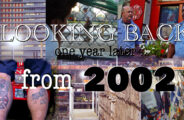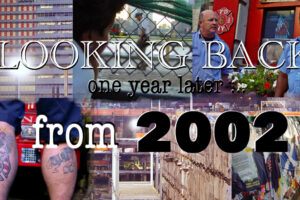Don Paul pitches N.F. council on feasibility funds for $50 million weather center

“The public’s interest in weather is inexhaustible,” said local meteorologist Don Paul as he began to address the Niagara Falls City council on Tuesday.
He was there with Sergio Fornasiero and Dave Norton to share their vision for a $50-million World Weather Center, possibly in Niagara Falls, New York.
It would include numerous high-tech simulators including tornado-storm chasing on the ground and in the air as well as a “Blizzard of ’77” experience that would include 1970s street scenes and cars with artificially produced snow.
The group is promoting their idea and looking for $100,000 to fund a feasibility study that will determine the best site, size and scope for the weather center, which will also include a scientific conference space and position itself as a regional education destination.
“There is a huge body of research to prove that,” Paul said of people’s interest in weather. “That’s the reason that on any given night if you watch the network news at 6:30 you will see a weather story because local TV has been researching focus groups every year. It’s the number-one reason people watch local news. Not on every single day. Today, it’s Rex Ryan. But that’s generally the biggest draw. And the networks began doing similar research about 10 to 15 years ago.”

“When I was a child the weather didn’t happen in New York or Washington. Walter Cronkite didn’t talk about it.”
“We know that this interest is inexhaustible. And it’s what built not just The Weather Channel but also helped to build the Discovery Channel and other cable networks.”
“So we know we are going to offer an engaging experience for the visitors who are involved and become active participants.”
“For example, we will have an experiential attraction where we follow our mascot — an arctic tern — which has the longest migratory route of any migratory bird on a trip to all of the climate zones.”
“In the western hemisphere we start at the south pole, Antarctica; then moving north toward a desert a lot of people haven’t heard of in Chile. But it’s the driest desert in the world. Drier than the Sahara. Then we move to the Amazon rainforest which has a flora and fauna with huge amounts of variants from the top of the tree canopy down to the jungle floor. There we would have animals and plant life where the visitors would actually be able to travel through.”
“Then we move to the hurricane country, the Gulf of Mexico, where both the Caribbean coasts and the U.S. coasts are impacted. As you know, most years we have a certain amount of hurricane activity. We’ve been very fortunate the last few years.”
“Move from there northward to Tornado Alley: Texas, Oklahoma, Kansas, with three-dimensional and beyond experiential exposure to the development of chromatic thunderstorms. Moving then farther north in the North American continent to the Tundra where — just as an example — it’s a place to introduce certain aspects of climate change.”
“The permafrost is melting. Climate models predicted the most rapid warming would occur in the Arctic, and that’s exactly what’s happened. And because of the permafrost melting, methane is being released that was trapped in the permafrost, and methane is a greenhouse gas. It doesn’t last as long CO2 but it actually retains heat 23 times more efficiently in the greenhouse effect.”
“Then we would move from the tundra over to Western New York and have a more localized focus on our weather. And so much of it is tied to the Great Lakes. Not just in “Lake Effect” snow but it also gives us beautiful summers here. It brings us the cool lake waters and gives us more sunshine in September than most of the Northeast experiences.”
“It’s going to be a one-of-a kind destination. We know there are weather wings in science museums but none of them are all-inclusive. And the beauty of weather is that it’s constantly in flux. So no-one can come to our center and visit it and say ‘I’ve seen all there is to see.”
“We are going to have a great hall where people can listen to a docent meteorologist explain, for example, that this weekend we had an absolutely roaring blizzard in the northern plains with winds gusting to over 80 miles an hour. And all of the satellite radar imagery from all the industrialized nations of the world is instantly archived so that we can display either ongoing weather on that day or maybe something that has occurred within the last few days. There’s always going to be new weather information to show.”
“And the technology, even though I work with high-definition graphics at Channel 7, some of this is even beyond me and it keeps changing.”
“The Omnimax Theater environment would give us the chance for a 4D immersive virtual tornado chase in which visitors actually choose which storm to chase. And that’s a dilemma every storm chaser faces. Each time there’s a big outbreak of violent thunderstorms, do you chase this cluster or that cluster? They will make their picks and actually go after it in a virtual environment.”
“And the virtual hurricane hunters will fly in a large fight simulator where they experience the turbulence of the hurricane-hunter flights, which ordinarily come out of Biloxi Mississippi but occasionally move out of other air bases. We can now simulate the storms that occur.”
“But the beauty of weather is you don’t have to exaggerate. It’s spectacular enough on its own. So we don’t have to add more fuel to the fire. It’s already there.”
“We are going to include masterful presentations and programs explaining the detection of weather systems in advance. For example, this recent storm that produced the blizzard — which last night gave us some warm gusty winds — was predicted by a computer model about 8 or 9 days ago. And when I was in college that was not yet possible. So we are going to present the weather without getting into the equations — we aren’t going to burden people with the math — but how these models are becoming greater in detail, where we can really zoom in on a storm days in advance.”
“There’s going be a local and regional impact. We are talking about attracting tourists, but this is also going to be a great draw for school systems, for trips to visit the center not only from Niagara and Erie counties but from regional centers centers such as Erie and Cleveland.”
That’s something that’s going to be ongoing even in cold weather. As you know, there are now more visitor attractions that aren’t totally reliant on warm summer days and this is going to be one of them.”
“There will be a display in the 1970s motif of the Blizzard of ’77, where people will be able to go into a blizzard room and experience it with artificially created snow with a 70s motif outside with a Buffalo street with 70s storefronts and 70s cars parked and get a feel for that. It could be a great draw for sunbelt people who come up to this city. A Buffalo-type blizzard or Western New York blizzard could be a great draw for people who live in Houston on Tampa and want to get out of that steambath. I lived in Tampa for a year and that was enough.”
“So they are already coming here, and if we can give them a center like this which immerses them, it’s another potential keeper where they get to say, ‘You know what? We’re going to stay tonight and go to the Center tomorrow.'”
“So we think we offer you some real potential to get people to stay here longer. We’ve had a company do some pro bono work for us. They’ve gone to exhibitors’ conventions — for several years on their dime — which is in Orlando every year. And these technological outfits by the time you build, as great as Omnimax is now, it’s going to be be a lot better, and the prices keep coming down. Initial costs have gotten lower on a lot of 3D and 4D systems.”
“We’re going to be able to educate about climate change without hammering people. Most of the meteorological community — and all of the climate scientists, atmospheric chemists and physicists — agree that warming is occurring. It doesn’t mean every part of the globe is warming at an equal rate or that every part of the globe is warming at once. But you can integrate that into the weather because climate is what you expect. Weather is what you get.”
“So there’s a tremendous educational potential here. And we’re also going to have a center for research and scientific conferences. The American Meteorological Society — my society — has had many conferences over the course of the years, and this would be a natural draw for those scientists to come here and sit in on those papers. And then in their spare time actually have some fun and enjoy the activities.”
Sergio Fornasiero, Vice President of The World Weather Center:
“It’s going be a major project. Probably 100,000 square feet. It’s going to be about a $50 million plus-or-minus investment. It’s something that would be a great asset to your community because of the potential you have with the natural environment of the Falls. People come here, they see the Falls. Many of them — most of them I would say — leave after a few hours. An attraction like this will attract them to stay longer, possibly stay at the hotels longer. More sales tax from the expenditures. More real estate taxes from future development. More hotels, restaurants, etc.”
“A facility like this, I think Niagara Falls could really use things like this to start other Falls projects rolling in terms of additional development. And even the pride of the local citizenry of Western New York — including obviously the Falls — in seeing all these people come in from out-of-town, staying for a while, and creating new jobs. We think it’s a magic thing for your city and Western New York.”
“We’ve been working hard for several years, raising money for a feasibility study that, of coursem before you go into the foundations and government and things like that they want to see the ‘meat on the bones’ so to speak, and so we’ve raised almost $50,000 so far but we need almost $200,000 to fund this thing in terms of having an executive eventually. But right now we are focusing on a feasibility study, and we have gone through the process of of requests for proposals and we’ve narrowed it down to a major international company from Cambridge, Massachusetts, that we are going to hire to do a feasibility study so they can tell us what site is best for it to be successful, tell us what size building we need, what the cost of the ticket will be, etc. and most importantly how many people it will and draw.”
“So we are very excited about our future steps. We are of course in need of some additional money to complete the feasibility study and we hope that you folks can understand that we have been working hard to raise money but we need more. If you folks can help us with finalizing the money for this feasibility study. We aren’t hiring people. We are all volunteers here that have been working years on our own here. We have nothing to gain personally on this project.”
Councilwoman Kristen Grandinetti: “Are you committed to the site being in Niagara Falls?”
“We are seriously considering Niagara Falls. We don’t want to open a facility that closes two years down the road because there was not enough people coming to see it. That’s why we are investing this money with a professional company to tell us where this thing will be most successful for the long term.”
Chairman Andrew Touma: “Other than New York City, we generate more tourists than anywhere in New York State. Have their been private investors?”
“That’s where the $50,000 we raised has come from, private individuals and companies,” Fornasiero said. “Step one is to find out where the best site would be and then we have to take the next step, which is how much money we need, how big it should be, how much capital funds we need. Each one is a step down the road.”
“We have a meeting scheduled early next month with IBM,” said Dave Norton, an electronic process engineer at Moog. “They own a company called The Weather Company and they want to see how much synergy there is. They are the largest private weather data vendor in the world, and they are expanding. They were intrigued by this project. So we are going to be meeting with them on the fourth. It was exciting to hear them get excited about this. They are flying people in from the center in Atlanta to meet with us in addition to their local people.”
Touma: “That was a a very interesting presentation. We appreciate you being here. We will certainly discuss your requests with the mayor and certainly appreciate you being here. This might have been one of the interesting presentations we’ve had.”
“We are working hard to make it come to fruition,” said Norton.
“And I hope to be a docent,” said Paul. “An unpaid position.”





































